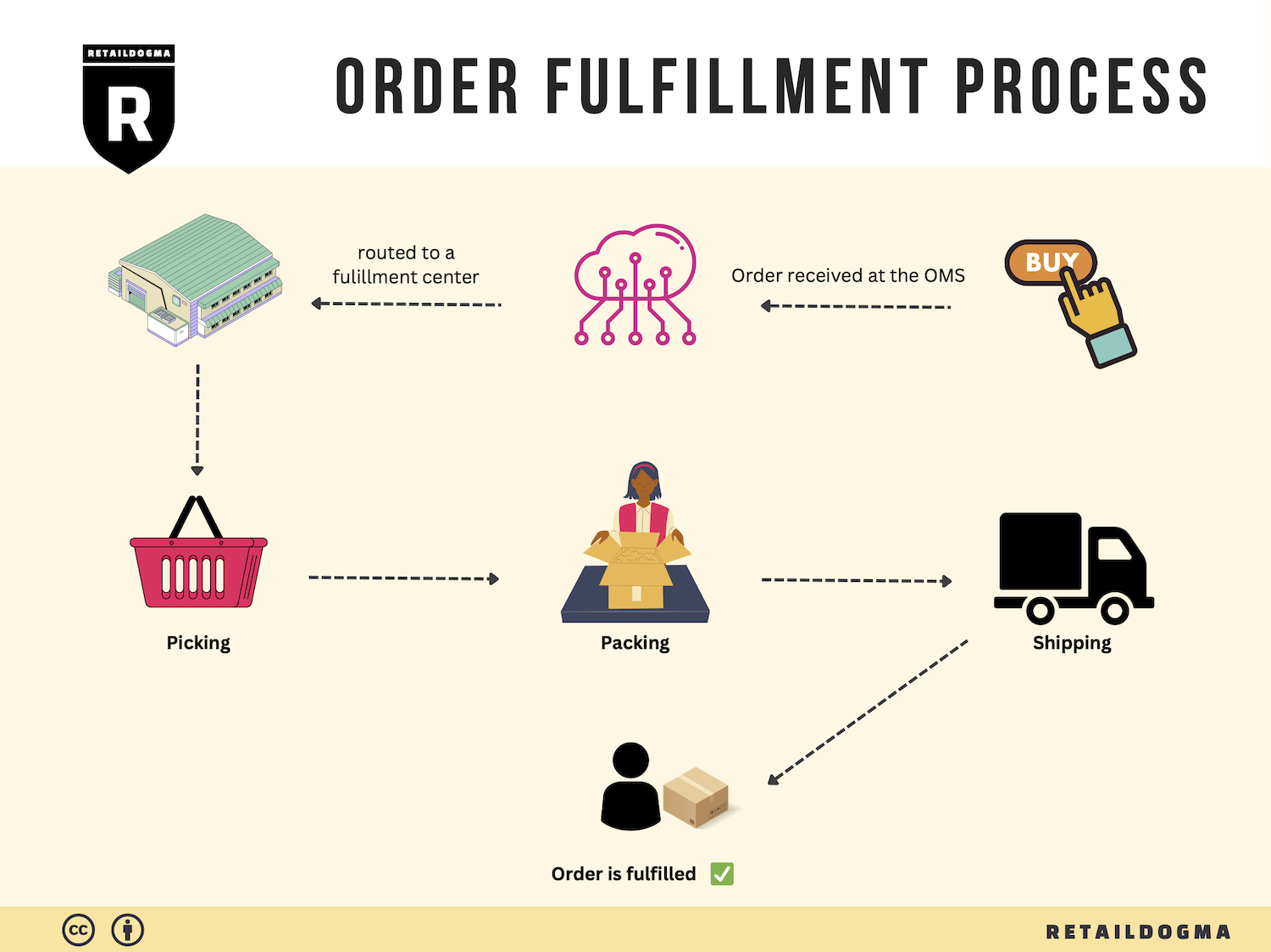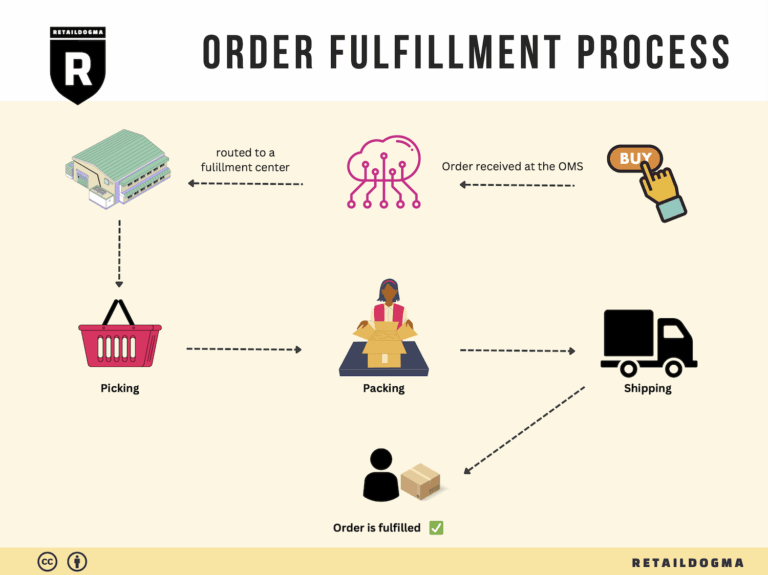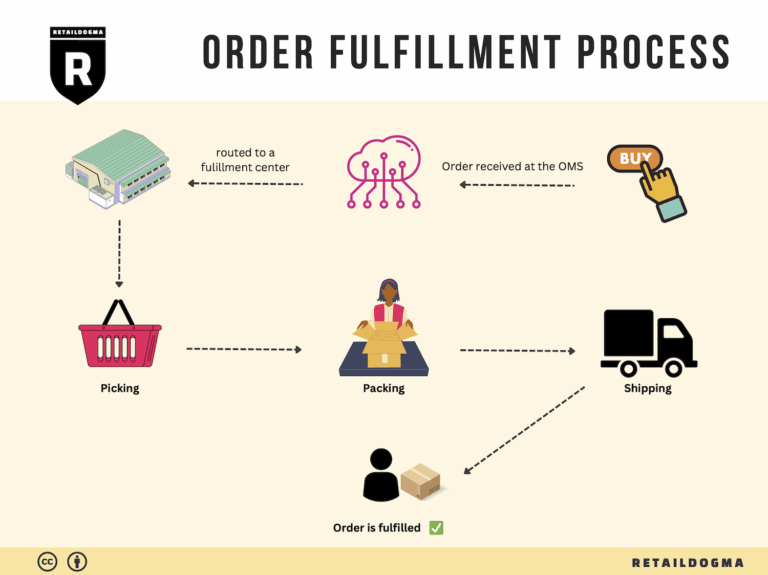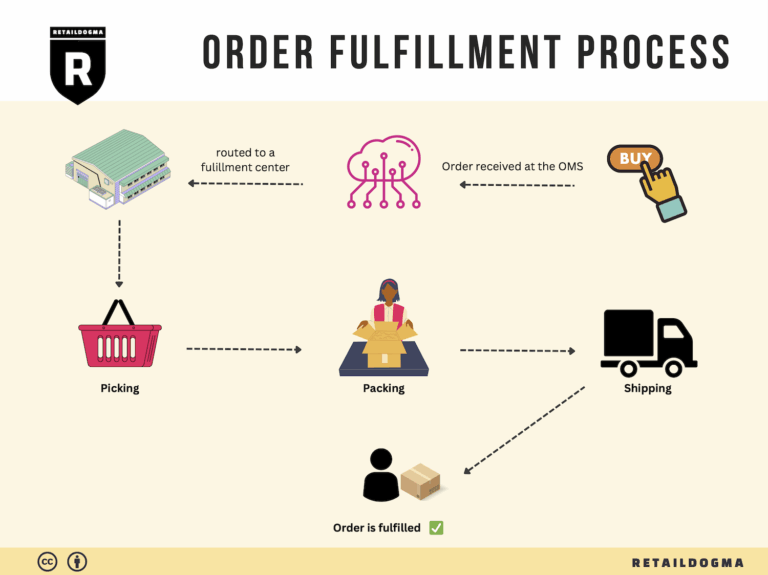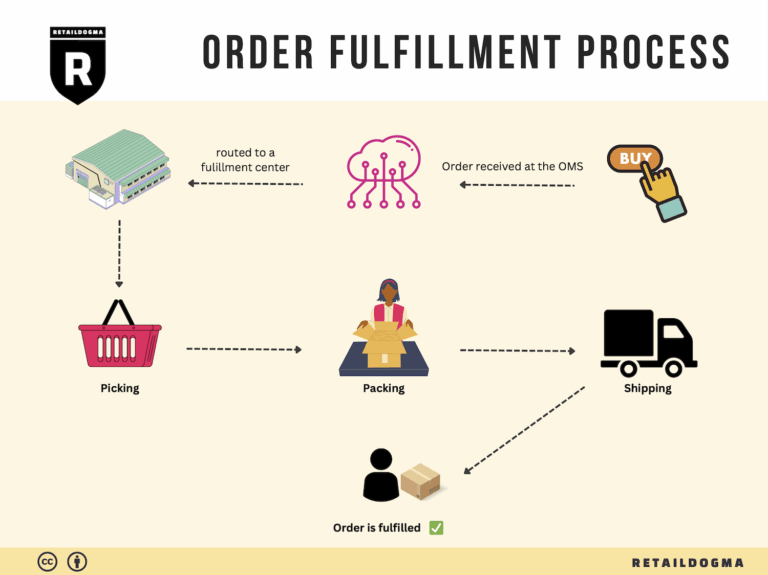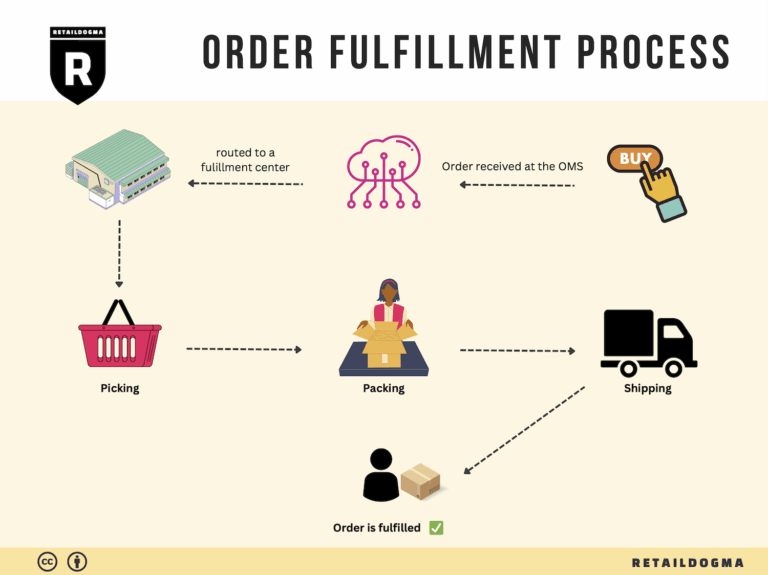What Is A Fulfillment Center? A Complete Guide (2025)
What is E-commerce Fulfillment? An Introduction for Growing Businesses
Understanding E-commerce Fulfillment: Alleviating Your Logistics Woes
As an e-commerce business owner, you’re likely familiar with the overwhelming demands of packing and shipping orders. The excitement of growing sales can quickly turn into stress when faced with the complexities of fulfillment. From managing inventory to ensuring timely deliveries, the logistics of getting products to customers can be daunting. This is where e-commerce fulfillment comes into play.
E-commerce fulfillment is simply the process of receiving, processing, and delivering orders to customers. It encompasses everything from warehousing and inventory management to packing and shipping. As your business scales, the intricacies of fulfillment can become more pronounced, making it essential to understand the various options available to you.
This guide will explore the different fulfillment models available to online retailers, including Third-Party Logistics (3PL) and Fulfillment by Amazon (FBA). Each model has its advantages and challenges, and understanding these can help you make informed decisions that align with your business goals.
We will delve into core fulfillment services that can streamline your operations, such as pick and pack services, inventory management, and returns processing. Effective inventory management is crucial; it ensures that you have the right products in stock, minimizing the risk of stockouts or overstocking. Additionally, we will discuss how to create memorable unboxing experiences that enhance customer satisfaction and loyalty.
Choosing the right fulfillment partner is critical for your business’s growth. We’ll provide practical tips on what to look for in a logistics partner, including their track record, customer service, technology integration capabilities, and pricing structures. Understanding the costs associated with different fulfillment services will empower you to make financial decisions that support your business’s bottom line.
Ultimately, this guide aims to equip you with the knowledge and insights needed to navigate the complexities of e-commerce fulfillment. By making informed decisions about your logistics, you can focus on what truly matters: growing your business, enhancing customer experiences, and driving sales. Whether you’re just starting out or looking to scale, understanding e-commerce fulfillment is key to your success in the digital marketplace.
What You’ll Learn In This Guide
- What is E-commerce Fulfillment? An Introduction for Growing Businesses
- The Order Fulfillment Process: From ‘Buy’ Button to Customer’s Door
- Comparing Fulfillment Models: In-House vs. 3PL vs. Dropshipping
- A Deep Dive into Amazon FBA: Pros, Cons, and Who It’s For
- Core Services Offered by Fulfillment Centers
- How to Choose a Fulfillment Partner: A 6-Point Checklist
- Understanding Fulfillment Pricing: A Breakdown of Common Fees
- Frequently Asked Questions (FAQs) about Fulfillment
- Conclusion: Is Outsourcing Fulfillment the Right Move for Your Business?
- Important Disclaimer
The Order Fulfillment Process: From ‘Buy’ Button to Customer’s Door
1. Receiving Inventory
The first step in the order fulfillment process is receiving inventory. This involves the acceptance of goods from suppliers or manufacturers into your fulfillment center. Upon arrival, inventory is checked against purchase orders to ensure accuracy in quantity and quality. Each item is then assigned a Stock Keeping Unit (SKU), a unique identifier that simplifies tracking and inventory management.
Importance: Efficient receiving practices are crucial for maintaining accurate inventory levels and minimizing discrepancies. A well-managed receiving process helps prevent stockouts and overstock situations, which can significantly impact customer satisfaction and operational costs.
2. Warehouse Storage
Once inventory is received and logged, it is stored in a designated area within the warehouse. Effective warehouse storage involves organizing products in a manner that maximizes space while ensuring easy accessibility. This can include the use of shelving, bins, or pallets, depending on the nature of the products. Additionally, implementing a systematic layout, such as the ABC analysis (where high-demand items are placed closer to the packing area), enhances efficiency.
Importance: Proper storage is essential for quick retrieval during the picking process. An organized warehouse reduces the time spent searching for items, ultimately speeding up order fulfillment and improving overall operational efficiency.
3. Order Picking
Order picking is the process of retrieving items from storage to fulfill customer orders. It typically begins when a customer places an order online, triggering a pick list—a document that outlines which items need to be collected, their quantities, and their storage locations. Warehouse staff use this list to gather the required products.
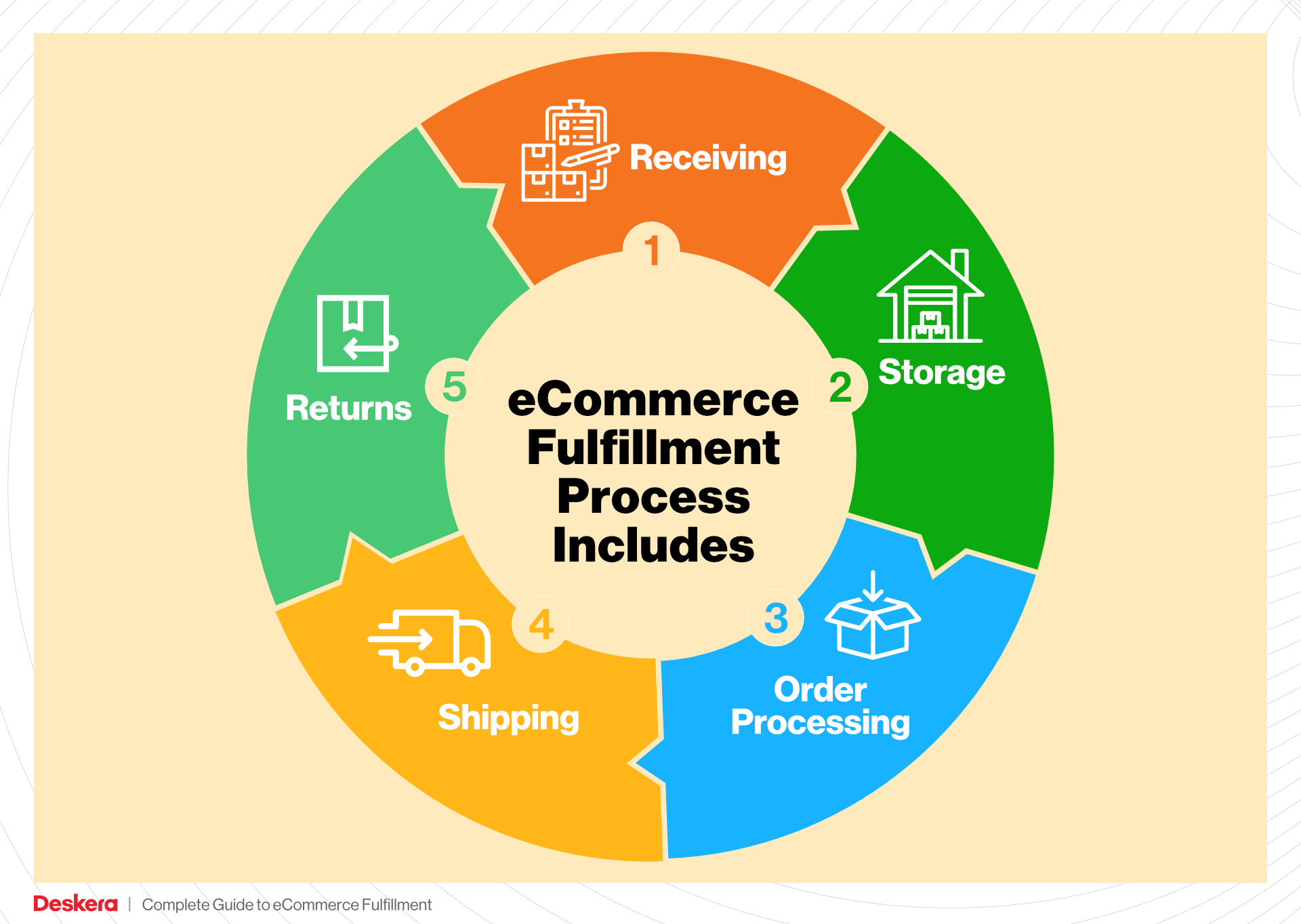
Importance: Accurate picking is vital, as mistakes can lead to incorrect shipments, customer dissatisfaction, and increased return rates. Implementing technologies like barcode scanners or pick-to-light systems can enhance picking accuracy and efficiency, ensuring that the right products are selected every time.
4. Order Packing
After items have been picked, they move to the packing station, where they are prepared for shipment. During this step, products are carefully packed in appropriate materials to prevent damage during transit. This includes using protective packaging such as bubble wrap or foam peanuts, as well as selecting the right-sized boxes. Additionally, packing slips and return labels are included, and the package is weighed and labeled for shipping.
Importance: Effective packing not only protects products but also enhances the customer experience. A well-packed order reflects professionalism and care, contributing to positive brand perception. Moreover, optimizing packing processes can reduce shipping costs by minimizing package weight and dimensions.
5. Shipping & Delivery
The final step in the fulfillment process is shipping and delivery. Once packed, orders are handed over to shipping carriers for delivery to customers. Businesses often partner with multiple carriers (e.g., USPS, UPS, FedEx) to provide various shipping options, ensuring timely and cost-effective deliveries. Tracking numbers are generated and communicated to customers, allowing them to monitor their order status.
Importance: Timely shipping is a critical factor in customer satisfaction. In today’s competitive e-commerce landscape, fast and reliable delivery can differentiate your business from others. Additionally, effective shipping management helps control costs and improves operational efficiency, ultimately contributing to better profit margins.
Conclusion
Understanding each step of the order fulfillment process is essential for e-commerce business owners, operations managers, and entrepreneurs. By streamlining these steps—from receiving inventory to shipping and delivery—you can enhance customer satisfaction, reduce operational costs, and scale your business effectively. Implementing best practices in each area will not only improve your fulfillment efficiency but also strengthen your brand’s reputation in the market.
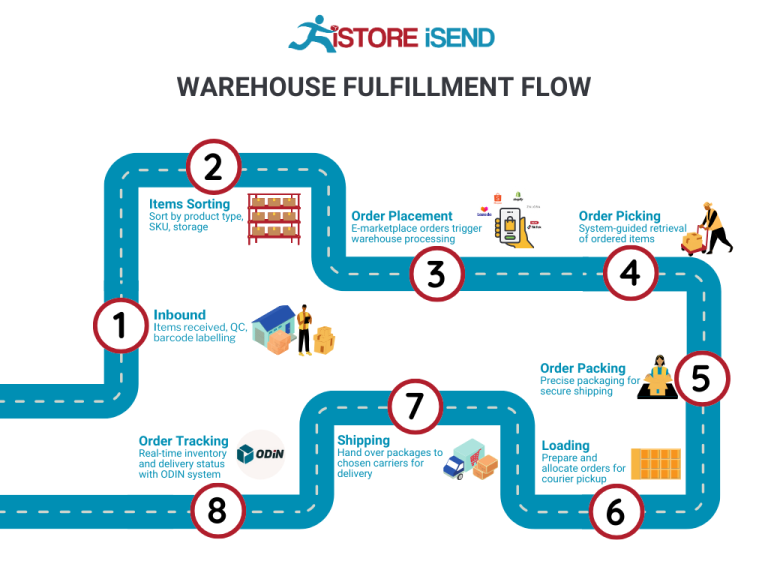
Comparing Fulfillment Models: In-House vs. 3PL vs. Dropshipping
Fulfillment Model Comparison
| Model | Who Handles Inventory | Best For (Business Stage) | Key Advantage | Key Disadvantage |
|---|---|---|---|---|
| In-House Fulfillment | The business itself | Established businesses | Full control over inventory and processes | High overhead costs and resource requirements |
| Third-Party Logistics (3PL) | A third-party logistics provider | Start-ups to mid-sized businesses | Scalable solutions and reduced costs | Less control over fulfillment processes |
| Dropshipping | Supplier or manufacturer | New businesses or niche products | Low initial investment and overhead | Lower profit margins and longer shipping times |
In-House Fulfillment
In-house fulfillment refers to the process where a business manages its own inventory and order fulfillment operations. This model is typically suited for established businesses that have the resources and demand to justify the investment in warehouse space, staff, and technology. One of the primary advantages of in-house fulfillment is the complete control it provides over inventory management, order accuracy, and customer service. Businesses can implement tailored processes and maintain a direct relationship with their customers, which can enhance brand loyalty and customer satisfaction.
However, the in-house model comes with significant drawbacks. It requires substantial upfront investment in facilities, equipment, and human resources. Additionally, ongoing operational costs, including rent, utilities, and payroll, can become burdensome, particularly for small businesses or those experiencing fluctuations in demand. Managing logistics can also distract from core business functions, such as marketing and product development, making it a less flexible option for companies looking to scale quickly.
Third-Party Logistics (3PL)
Third-party logistics (3PL) providers offer specialized services to manage various aspects of logistics and fulfillment on behalf of businesses. This model is ideal for start-ups and mid-sized businesses that require scalable solutions without the overhead associated with in-house fulfillment. 3PL companies typically handle warehousing, inventory management, order processing, and shipping, allowing businesses to focus on growth and customer engagement.
The key advantage of utilizing a 3PL service is the cost-effectiveness and flexibility it provides. Businesses can scale their operations up or down based on demand, without the need for significant capital investment in physical infrastructure. Additionally, many 3PL providers offer advanced technology solutions for inventory management and tracking, which can enhance operational efficiency.
However, the main disadvantage of working with a 3PL provider is the loss of direct control over the fulfillment process. Businesses must rely on the 3PL’s systems and processes, which can lead to inconsistencies in order accuracy and customer service. Furthermore, the quality of service can vary widely among 3PL providers, making it crucial to choose a reliable partner who aligns with your business goals and customer expectations.
Dropshipping
Dropshipping is a fulfillment model where a business sells products without holding any inventory. Instead, when a customer makes a purchase, the order is forwarded to a third-party supplier who then ships the product directly to the customer. This model is particularly appealing for new businesses or those selling niche products, as it requires minimal upfront investment and eliminates the risks associated with unsold inventory.
The primary advantage of dropshipping is its low barrier to entry. Entrepreneurs can launch e-commerce stores without the need for warehousing, staffing, or large capital investments. This allows for greater flexibility in testing new products and markets. Additionally, dropshipping can facilitate a diverse product range, as businesses can easily add or remove items based on demand without worrying about inventory management.

On the downside, dropshipping often results in lower profit margins compared to other fulfillment methods. Since suppliers typically charge a premium for their services, businesses may find it challenging to compete on price. Furthermore, shipping times can be longer, as products may need to travel from the supplier to the customer, which can negatively impact customer satisfaction. The lack of control over inventory and fulfillment processes can also lead to issues with order accuracy and quality, making it essential for businesses to carefully vet their suppliers.
Conclusion
Selecting the right fulfillment model is a critical decision for e-commerce businesses looking to scale. Each model—In-House Fulfillment, Third-Party Logistics (3PL), and Dropshipping—offers unique advantages and disadvantages that should align with your business’s specific needs, resources, and growth stage. By thoroughly evaluating these options and considering factors such as control, cost, and scalability, business owners can choose the fulfillment strategy that best supports their long-term success.
A Deep Dive into Amazon FBA: Pros, Cons, and Who It’s For
What is Fulfillment by Amazon (FBA)?
Fulfillment by Amazon (FBA) is a service that allows e-commerce sellers to leverage Amazon’s extensive logistics network for storage, packing, and shipping of their products. Sellers send their inventory to Amazon’s fulfillment centers, where the company takes over the process of order fulfillment. This includes not only picking and packing products but also handling customer service and returns. By utilizing FBA, sellers can focus on growing their business while benefiting from Amazon’s established infrastructure and customer base.
How FBA Works
-
Setup: Sellers create an FBA account and list their products on Amazon. During this process, they specify which products they want to fulfill through FBA.
-
Shipping Inventory: Sellers prepare their products and ship them to Amazon’s fulfillment centers. Amazon provides guidelines on how to package and label items for optimal efficiency.
-
Storage: Once the inventory arrives at the fulfillment center, Amazon stores the products until they are sold. The storage fees depend on the time of year and the amount of space the products occupy.
-
Order Fulfillment: When a customer places an order, Amazon takes care of the picking, packing, and shipping process. Products are shipped using Amazon’s logistics network, ensuring prompt delivery.
-
Customer Service: Amazon handles all customer inquiries and returns related to FBA orders, providing a seamless experience for both sellers and buyers.
-
Payment: After the sale is completed, Amazon transfers the revenue to the seller’s account, minus the applicable fees.
Pros of FBA
-
Prime Eligibility: Products fulfilled by Amazon are eligible for Amazon Prime, which can significantly boost sales. Prime members tend to prefer products that offer fast and free shipping, making FBA an attractive option for sellers.
-
Customer Trust: Leveraging Amazon’s brand recognition adds a layer of credibility to your products. Customers are more likely to purchase from sellers using FBA due to Amazon’s reputation for reliability and quality customer service.
-
Multi-Channel Fulfillment: FBA is not limited to Amazon sales. Sellers can use FBA to fulfill orders from their own websites or other marketplaces, streamlining their logistics and inventory management.
-
Scalability: FBA enables sellers to scale their operations efficiently. As sales increase, Amazon’s infrastructure can handle larger volumes without requiring significant changes on the seller’s part.
-
Time Savings: By outsourcing logistics to Amazon, sellers can save time on order fulfillment, allowing them to focus on marketing, product development, and other core business activities.
Cons of FBA
-
High Fees: FBA comes with various fees, including storage fees for inventory held at Amazon’s warehouses and fulfillment fees based on the size and weight of the products. These costs can add up, especially for low-margin products.
-
Strict Inventory Rules: Amazon enforces strict inventory management practices. Sellers must ensure that their inventory is compliant with Amazon’s requirements, which can be challenging for those managing large quantities of products.
-
Commingling Risks: FBA operates on a commingling model, where inventory from multiple sellers may be stored together. This can lead to issues if a seller’s product is mistakenly sent instead of another seller’s, potentially harming their reputation.
-
Limited Control: Once you enroll in FBA, you relinquish some control over the fulfillment process. Sellers must rely on Amazon to manage inventory, shipping, and customer service, which may not always align with their brand’s standards.
-
Return Handling: While Amazon manages returns, the process can be frustrating for sellers. Returned items may not always be in sellable condition, leading to potential losses.
Who is FBA Best For?
Fulfillment by Amazon is particularly well-suited for small to medium-sized e-commerce businesses looking to scale quickly without the burden of managing logistics. It is ideal for:
-
Startups: New businesses that want to enter the market quickly can benefit from Amazon’s vast reach and established customer base.
-
Established Brands: Brands looking to expand their reach and tap into the Prime customer segment can leverage FBA to enhance their visibility and sales.
-
Sellers with High Volume: Businesses that can maintain a steady flow of sales are likely to benefit from the economies of scale that FBA offers.
-
Multi-Channel Sellers: Companies that sell on multiple platforms and want a streamlined fulfillment process can take advantage of FBA’s multi-channel capabilities.
-
Niche Products: Sellers with unique or specialized products can gain credibility and visibility through Amazon’s marketplace, making FBA a strategic choice.
In conclusion, FBA presents a powerful opportunity for e-commerce businesses to streamline their logistics and enhance their sales potential. However, it is essential for sellers to weigh the pros and cons and consider their specific business model and goals before committing to this fulfillment strategy.
Core Services Offered by Fulfillment Centers
Inventory Management & Warehousing
Effective inventory management and warehousing are foundational to the success of any e-commerce business. Fulfillment centers provide secure storage solutions for your products, ensuring they are organized and easily accessible. This service typically includes real-time inventory tracking, which allows businesses to monitor stock levels, forecast demand, and make informed purchasing decisions.
The benefits of robust inventory management are manifold. By utilizing a fulfillment center’s advanced inventory management system, businesses can reduce the risk of stockouts or overstocking, both of which can negatively impact cash flow. Additionally, centralized warehousing enables quicker order processing, as products are stored in a location that facilitates efficient picking and packing. This ensures that orders are fulfilled accurately and shipped promptly, enhancing customer satisfaction and loyalty.
Moreover, many fulfillment centers offer flexible storage options without long-term commitments, which is particularly advantageous for seasonal businesses or startups with fluctuating inventory needs. This flexibility allows e-commerce businesses to scale operations up or down based on demand without incurring unnecessary costs.
Pick and Pack Services
Pick and pack services are at the heart of the fulfillment process. This service involves selecting (picking) the ordered products from the warehouse and then packaging (packing) them for shipment. Fulfillment centers employ trained staff and efficient systems to ensure that this process is executed with high accuracy and speed.
The primary benefit of utilizing professional pick and pack services is the significant reduction in operational burden for e-commerce businesses. By outsourcing this function, companies can focus on core activities such as marketing, product development, and customer engagement. Furthermore, experienced fulfillment centers maintain a high order accuracy rate, minimizing the likelihood of errors that can lead to returns and customer dissatisfaction.
Additionally, many fulfillment centers offer customizable packing options, allowing businesses to create a memorable unboxing experience for their customers. This can include branded packaging, personalized notes, or promotional inserts, which can enhance brand loyalty and encourage repeat purchases.
Kitting and Assembly
Kitting and assembly services provided by fulfillment centers involve grouping individual items together to create a single, ready-to-ship product. This can include bundling products for promotional offers, assembling complex products that require multiple components, or creating subscription boxes that contain curated items.
For e-commerce businesses, kitting and assembly services offer several advantages. First, they streamline the fulfillment process by allowing businesses to send complete kits or assembled products directly to customers. This not only saves time during order fulfillment but also enhances the customer experience by providing a ready-to-use product.
Additionally, kitting can help businesses manage inventory more effectively by reducing the number of individual SKUs they need to track. This simplification can lead to lower storage costs and easier inventory management. Furthermore, offering kitted products can create upsell opportunities, as customers may be more inclined to purchase bundled items at a perceived value, thereby increasing average order value.
Returns Management (Reverse Logistics)
Returns management, often referred to as reverse logistics, is a critical component of e-commerce fulfillment services. It encompasses the processes involved in handling returned merchandise, including receiving, inspecting, restocking, and processing refunds or exchanges.
The importance of an efficient returns management system cannot be overstated. A well-handled return process can significantly enhance customer satisfaction and foster brand loyalty. E-commerce businesses that offer hassle-free returns are more likely to retain customers, as shoppers are increasingly prioritizing return policies when making purchasing decisions.
Fulfillment centers often provide streamlined returns processing, allowing businesses to quickly assess returned items and update inventory accordingly. This ensures that products can be restocked and made available for resale in a timely manner, minimizing losses due to unsold inventory. Additionally, effective returns management can provide valuable insights into customer behavior and product quality, helping businesses identify trends and improve their offerings.
In summary, partnering with a fulfillment center for returns management not only mitigates the operational challenges associated with returns but also contributes to a positive overall customer experience, which is crucial for long-term success in the competitive e-commerce landscape.
By leveraging these core services—inventory management and warehousing, pick and pack services, kitting and assembly, and returns management—e-commerce businesses can enhance their operational efficiency, improve customer satisfaction, and ultimately scale their operations with confidence.
How to Choose a Fulfillment Partner: A 6-Point Checklist
Location & Warehouse Network
Importance:
The location of your fulfillment partner’s warehouses can significantly impact shipping times, costs, and overall customer satisfaction. A strategically placed warehouse network allows for quicker deliveries and lower shipping fees, especially if your customer base is spread across different regions.
Questions to Ask:
– Where are your warehouses located, and how do they align with our target markets?
– What is your average shipping time to key areas where our customers reside?
– Do you have plans for expanding your warehouse network in the future?
Technology & Integrations
Importance:
In today’s e-commerce landscape, technology plays a critical role in effective order management and inventory control. A fulfillment partner should offer robust technology that integrates seamlessly with your e-commerce platform, enabling real-time inventory tracking, order updates, and reporting.
Questions to Ask:
– What technology do you use for inventory management and order processing?
– Can your system integrate with our existing e-commerce platform or marketplaces (e.g., Shopify, Amazon)?
– Do you provide real-time tracking for orders, and how can we access this data?
Specializations (e.g., Cold Storage, Oversized Items)
Importance:
Not all fulfillment partners can handle the specific needs of every business. If you sell specialized products, such as perishables that require cold storage or oversized items that need special handling, it is crucial to choose a partner that can accommodate these requirements.
Questions to Ask:
– What types of products do you specialize in handling?
– Do you have facilities for temperature-sensitive products, or can you manage oversized items?
– What additional services do you offer, such as kitting or custom packaging?
Scalability & Capacity
Importance:
As your business grows, your fulfillment needs will likely change. A capable fulfillment partner should be able to scale operations efficiently to meet your growing demands without compromising service quality.
Questions to Ask:
– How do you handle peak seasons or sudden surges in order volume?
– What is your current capacity, and how quickly can you scale operations if our order volume increases?
– Do you have a track record of working with businesses that experienced rapid growth?
Pricing and Contracts
Importance:
Understanding the pricing structure and contract terms is essential to avoid unexpected costs and ensure a financially viable partnership. Transparency in pricing helps you budget effectively and assess the overall value of the services provided.
Questions to Ask:
– What is your pricing model (e.g., per order, per item, flat rate)?
– Are there any hidden fees, such as for storage, returns, or integrations?
– What are the terms of your contracts? Is there flexibility for short-term engagements or trial periods?
Customer Support & Reviews
Importance:
Excellent customer support can make or break your fulfillment experience. A partner that provides responsive and knowledgeable support can help resolve issues quickly, ensuring minimal disruption to your operations. Additionally, reviews and testimonials from other businesses can provide insights into the partner’s reliability and service quality.
Questions to Ask:
– What support channels do you offer (e.g., phone, email, chat), and what are your response times?
– Can you provide references or case studies from businesses similar to ours?
– How do you handle customer complaints or issues related to fulfillment errors?
Conclusion
Choosing the right fulfillment partner is a crucial decision for scaling your e-commerce business. By using this checklist, you can evaluate potential partners based on their location, technology capabilities, specializations, scalability, pricing structures, and customer support. Careful consideration of these factors will help you find a fulfillment partner that aligns with your business goals and contributes to your long-term success.
Understanding Fulfillment Pricing: A Breakdown of Common Fees
Initial Setup Fees
When engaging with a fulfillment service provider, many businesses encounter initial setup fees. These fees cover the costs associated with onboarding your account, including the configuration of software systems, integration with your e-commerce platforms, and the establishment of your inventory in the warehouse. Setup fees can vary widely based on the complexity of your operations and the specific requirements of the fulfillment provider.
To calculate initial setup fees, providers may consider factors such as the number of SKUs you have, the level of integration required, and any special services you might need (like kitting or custom packaging). It’s essential to clarify what these fees encompass and whether they are one-time charges or recurring expenses.
Receiving Fees
Receiving fees are charged when your inventory arrives at the fulfillment center. These fees cover the labor and resources required to unload, inspect, and store your products. Each time a shipment of inventory is received, this fee is applicable.
Typically, receiving fees are calculated based on the volume or weight of the shipment. For instance, a provider may charge a per-pallet fee or a fee per 100 pounds of product. Understanding how your shipments will be received and the associated costs will help you budget effectively.
Storage Fees (per pallet/bin)
Storage fees are incurred for the space your inventory occupies within the fulfillment center. These fees can be structured in various ways, such as per pallet or per bin, depending on how the warehouse organizes its space.
Storage fees are usually charged monthly and can vary based on factors like the location of the warehouse and the duration for which your products are stored. Some fulfillment providers may offer tiered pricing, where the cost per pallet decreases as you store more units. It’s crucial to monitor your inventory turnover to minimize storage fees, as prolonged storage can lead to increased costs.
Pick & Pack Fees (per item/order)
Pick and pack fees are one of the most significant components of fulfillment pricing. These fees cover the costs associated with retrieving your items from storage, packing them for shipment, and preparing them for delivery.
Pick and pack fees are often charged on a per-item basis or per order. For example, a provider may have a base fee for picking and packing the first item and a smaller fee for each additional item in the same order. Understanding the nuances of these fees is critical, especially if you have a diverse product range or expect to scale your operations.
Shipping Fees
Shipping fees encompass the costs of transporting your products from the fulfillment center to the end customer. These fees can vary based on several factors, including the shipping method (standard, expedited, international), the weight and dimensions of the package, and the destination.
Shipping fees are typically calculated based on carrier rates, which can fluctuate depending on fuel prices and demand. Many fulfillment providers negotiate bulk shipping rates with carriers, allowing them to pass on savings to you. It’s essential to explore the shipping options provided by your fulfillment partner and understand how these fees are calculated to optimize your shipping strategy.
Tips for Getting an Accurate Quote
-
Be Transparent About Your Needs: Clearly outline your inventory types, expected order volumes, and any special requirements (like kitting or custom packaging). The more information you provide, the more accurate your quote will be.
-
Request Detailed Breakdown: Ask for a detailed breakdown of all fees, including any potential hidden costs. Ensure you understand each fee component and its basis of calculation.
-
Compare Multiple Providers: Don’t settle for the first quote you receive. Compare offers from several fulfillment service providers to gauge competitive pricing and services.
-
Consider Future Growth: Discuss your growth projections with potential providers. They should be able to offer scalable solutions that accommodate your business’s evolving needs.
-
Inquire About Discounts: Some fulfillment centers offer volume discounts for larger shipments or long-term contracts. Explore these options to potentially reduce costs.
Understanding fulfillment pricing is crucial for managing your e-commerce logistics effectively. By familiarizing yourself with common fees and asking the right questions, you can choose a fulfillment partner that aligns with your business goals and supports your growth.
Frequently Asked Questions (FAQs) about Fulfillment
1. What is a fulfillment service?
A fulfillment service is a third-party logistics (3PL) provider that manages the storage, packaging, and shipping of products on behalf of an e-commerce business. This includes receiving inventory, picking and packing orders, managing returns, and shipping products directly to customers.
2. What’s the difference between a warehouse and a fulfillment center?
While both warehouses and fulfillment centers are used for storing goods, the key difference lies in their purpose. A warehouse primarily focuses on storage and inventory management, often for bulk goods. In contrast, a fulfillment center is designed to handle the entire order processing workflow, including packing and shipping, to ensure timely delivery to customers.
3. How does a fulfillment service work?
Fulfillment services operate by integrating with your e-commerce platform. When an order is placed, the service picks the item from inventory, packs it according to your specifications (which may include branding), and ships it to the customer. They also handle returns and provide real-time inventory tracking.
4. What is a 3PL?
A third-party logistics (3PL) provider is a company that offers outsourced logistics services, which encompass warehousing, fulfillment, and shipping. 3PLs allow e-commerce businesses to focus on their core activities while leveraging the expertise of logistics professionals.
5. How much do fulfillment services cost?
The cost of fulfillment services can vary widely based on factors such as order volume, storage space, shipping methods, and additional services (like kitting or custom packaging). Many providers offer transparent pricing structures with no hidden fees, allowing businesses to budget effectively.
6. How can fulfillment services help my business scale?
Fulfillment services can help your business scale by providing the infrastructure and expertise needed to handle increased order volumes. By outsourcing logistics, you can focus on marketing and product development, while a fulfillment partner ensures efficient order processing and shipping, helping you to grow without the burden of managing logistics in-house.
7. What should I look for in a fulfillment partner?
When selecting a fulfillment partner, consider their experience in your industry, the range of services offered, technology integration capabilities, shipping options, and customer service quality. A good partner should also provide real-time tracking and reporting to help you monitor your operations.
8. Can I customize packaging with a fulfillment service?
Yes, many fulfillment services offer customizable packaging options to enhance your brand’s identity. This can include branded boxes, packing slips, and even personalized messages, allowing you to create memorable unboxing experiences for your customers.
9. How do I manage inventory with a fulfillment service?
Most fulfillment services provide real-time inventory management systems that integrate with your e-commerce platform. This allows you to monitor stock levels, receive alerts for low inventory, and forecast future needs, ensuring you can meet customer demand without overstocking.
10. What happens if a customer wants to return a product?
Fulfillment services typically offer returns management, handling the entire return process from receiving the item back to inspecting and restocking it. This ensures that your inventory is always accurate and allows you to provide a seamless return experience for your customers.
Conclusion: Is Outsourcing Fulfillment the Right Move for Your Business?
Evaluating the Benefits of Outsourcing Fulfillment
Outsourcing fulfillment can be a transformative strategy for e-commerce businesses looking to scale effectively. One of the most significant advantages is the time saved—business owners can redirect their focus from logistics to core business activities, such as marketing and product development. By partnering with a fulfillment service, you can ensure that orders are processed efficiently, allowing you to respond quickly to customer demands.
Scalability is another critical benefit. As your business grows, so do the complexities of order fulfillment. A reliable fulfillment partner can seamlessly accommodate increasing order volumes without the need for additional infrastructure investments or hiring new staff. This flexibility is essential for businesses aiming for sustainable growth in a dynamic market.
Moreover, leveraging the expertise of a fulfillment service can enhance your operational efficiency. Experienced providers bring knowledge in inventory management, shipping logistics, and returns processing. This expertise not only minimizes errors but also optimizes shipping costs, allowing you to pass savings on to your customers.
However, the success of outsourcing fulfillment hinges on choosing the right partner. Not all fulfillment services offer the same level of support, technology, or reliability. Therefore, it’s crucial to conduct thorough research and select a provider that aligns with your business needs and growth objectives.
Call to Action
To determine if outsourcing fulfillment is the right step for your business, consider conducting an audit of your current shipping process. Evaluate your order volume, shipping times, and customer satisfaction levels. Identify bottlenecks and areas for improvement. By assessing your fulfillment capabilities, you can make informed decisions about partnering with a 3PL provider that can help propel your business to new heights. Take the first step today—your future growth may depend on it.
Important Disclaimer
⚠️ Important Disclaimer
The information in this guide is for educational purposes. Fulfillment services, pricing, and platform features change frequently. Always conduct your own due diligence and consult with providers directly before making business decisions.
